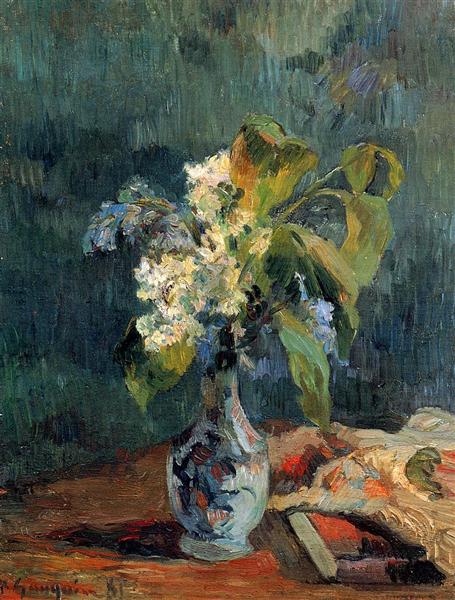Description
Paul Gauguin's "Bouquet of Lilacs", created in 1885, is situated at a turning point in the artist's career, marked by his search for a deeper expression through colour and form. This painting, still in its early stages of artistic maturity, reveals the transition towards post-impressionism that Gauguin would later explore, opening a path towards his explorations in Polynesia and its intense symbolist colours.
In “Bouquet of Lilacs,” the composition focuses on a lush, vibrant bouquet of lilacs, which emerges with great force from the more subtle and less defined background. The choice of floral motif is not accidental; flowers, often symbols of ephemeral beauty and transience, also suggest a desire to delve deeper into intimacy and emotion. The lilacs, with their purple and lilac hues arranged in a vase, not only invite the viewer to observe, but seem to vibrate on their own, offering an air of freshness and fragility that is both visual and emotional.
Gauguin uses a rich, saturated palette, a characteristic that would gradually come to define his style. Vibrant colours, combined with shadows and lights, breathe life into the flowers. Each petal appears to be a flash of light, while the background, painted in more muted tones, serves to enhance the luminosity of the bouquet. The arrangement of the lilacs, especially on the right side, creates an almost sculptural effect, providing textures and a sense of movement. The brushwork is determined but fluid, suggesting an intuitive connection between the artist and his subject.
There are no characters in the work, which resonates with Gauguin's focus on nature and the exploration of the beauty that it can offer on its own, without the interference of the human figure. This correlates with his artistic philosophy, where the natural and the simple are elevated to a plane of great aesthetic importance. Gauguin, who was a pioneer in the use of color as the main expressive vehicle beyond faithful representation, finds in this bouquet of lilacs a way to manifest deep emotions, a longing for the transcendent.
The context of the creation of "Bouquet of Lilacs" is interesting in itself. In 1885, Gauguin was in a period of personal and artistic exploration, enriched by his contact with the Impressionist movement and the influence of artists such as Edgar Degas and Camille Pissarro. His early works, although aligned with Impressionism, began to mark a divergence towards a search for purity and symbolism. The work perfectly captures this crossroads, where technique becomes a vehicle for the expression of the soul.
Compared to other works from the same period, "Bouquet of Lilacs" can be placed alongside the works of contemporary artists such as Vincent van Gogh, who shared the same passion for the flower and the emotional use of colour. However, despite its thematic proximity, Gauguin's interpretation carries with it a personal imprint and a verve that, although framed within the tradition of Impressionism, feels at once unique and anticipatory of his future works.
Thus, "Bouquet of Lilacs" is not just a representation of a floral composition; it rises to be a testimony to Paul Gauguin's evolution, a further step towards his personal search for an aesthetic that would go beyond mere representation, and a longing for an artistic language that would speak directly to the human heart. With its vibrant palette and electrifying composition, the work is a celebration of beauty and an invitation to look beyond the visible.
KUADROS ©, a famous painting on your wall.
Hand-made oil painting reproductions, with the quality of professional artists and the distinctive seal of KUADROS ©.
Painting reproduction service with satisfaction guarantee. If you are not completely satisfied with the replica of your painting, we will refund 100% of your money.

